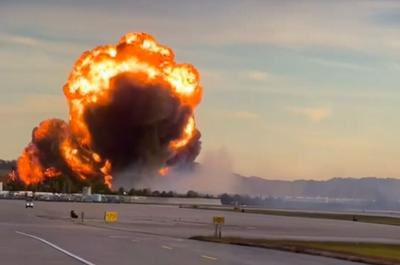Federal investigators released dramatic photos Thursday of an engine flying off a doomed UPS cargo plane that crashed two weeks ago in Kentucky, killing 14 people, and said there was evidence of cracks in the left wing's engine mount.
A series of six photos showed the rear of the engine starting to detach before it flew up and over the wing as flames erupted. The next image shows the wing engulfed by fire as the burning engine flies above it. The last image shows the plane starting to get airborne.
But the MD-11 plane only got 30 feet (9.1 meters) off the ground, the National Transportation Safety Board said, citing the flight data recorder in its first formal but preliminary report about the Nov. 4 disaster in Louisville, Kentucky.
Three pilots on the plane were killed along with 11 more people on the ground near Muhammad Ali International Airport.
The NTSB said the plane was not due yet for a detailed inspection of key engine mount parts that had fractures. It still needed to complete nearly 7,000 more takeoffs and landings. It was last examined in October 2021.
“It appears UPS was conducting this maintenance within the required time frame, but I’m sure the FAA is now going to ponder whether that time frame is adequate,” former federal crash investigator Jeff Guzzetti told The Associated Press after reading the report.
All MD-11s grounded for now
It's not clear when the cracks started to develop on the 34-year-old plane and whether they could have been missed in that earlier inspection. Another aviation expert, John Cox, described fatigue cracks as "normal wear and tear on an aircraft.”
He said a metal part, like the engine mount that vibrates every time the plane flies, will eventually develop cracks. Cox noted it's just a question of how often those parts need to be inspected and what maintenance is required.
The NTSB report revealed the first new details since board member Todd Inman briefed reporters on Nov. 7. He said the cockpit voice recorder captured an alarm bell going off about 37 seconds after the UPS crew called for takeoff thrust.
“It’s one thing to be involved in a natural disaster and another thing to be involved in a man-made, human error tragedy, and that’s what we believe this is,” said Sean Garber, who looked at the report and whose auto salvage yard near the airport took a direct hit.
All MD-11s used by UPS, FedEx and Western Global — along with a few related DC-10s — were grounded after the crash until they can be inspected and repaired, but the Federal Aviation Administration hasn't said what will be required.
Cox said those air carriers “are going to have to make some hard decisions” because they were already planning to retire the planes in the next few years.
“If you have to pull the engines off and do some sort of visual inspection or replacement, that’s going to run into a significant cost," he said.
MD-11 aircraft make up about 9% of the UPS fleet and 4% of the FedEx fleet, the companies have said.
UPS will wait for crash conclusions
Earlier this week, Bill Moore, president of UPS Airlines, an arm of UPS, said the company is working with investigators to determine the key cause of the crash.
“Once we determine that, then they’ll be able to develop an inspection plan,” Moore said at a news conference in Louisville. “Can we inspect it? If so, how do we repair it? How do we put it back together? And then eventually return the fleet to service. But that’s not going to happen quickly.”
The NTSB report said there was a similar event in Chicago in 1979 when an American Airlines DC-10 crash killed 273 people. The DC-10 was the predecessor of the MD-11.
“The left engine and pylon assembly and about 3 ft of the leading edge of the left wing separated from the airplane and fell to the runway,” the report said.
Former federal crash investigator Alan Diehl said he hopes the Federal Aviation Administration reevaluates plane maintenance schedules and considers high-tech methods to examine metal, not just visual inspections.
“It is clear that engine pylon attachment failures are these aircraft’s Achilles' heels,” Diehl said.
The MD-11 and the DC-10 have some of the highest accident rates of any commercial planes, according to statistics published annually by Boeing.
Meanwhile, mourning continued in Louisville, more than two weeks after the tragedy. The Louisville Orchestra was presenting a free concert Thursday evening.
“Music brings comfort," Music Director Teddy Abrams said.
Associated Press writer Bruce Schreiner in Louisville, Kentucky, contributed to this report.











